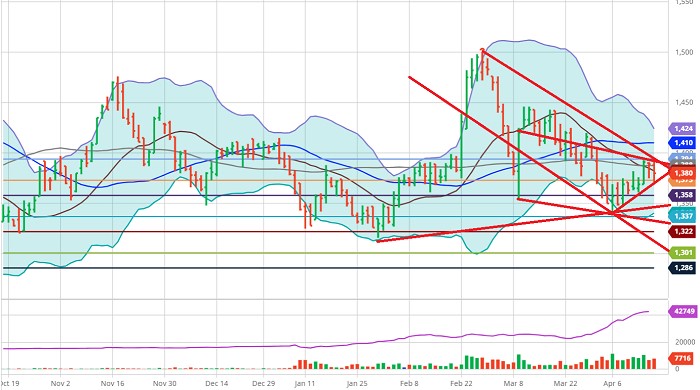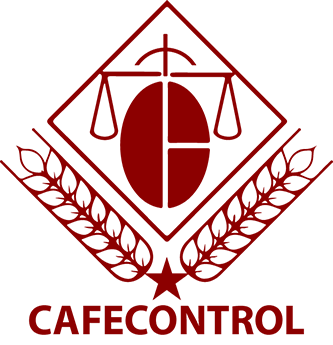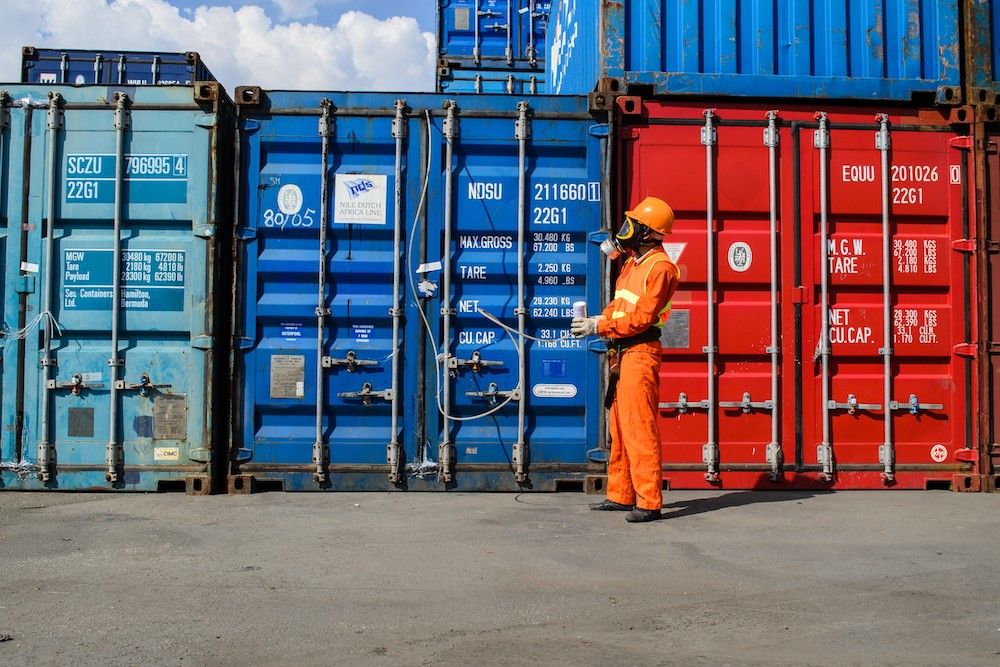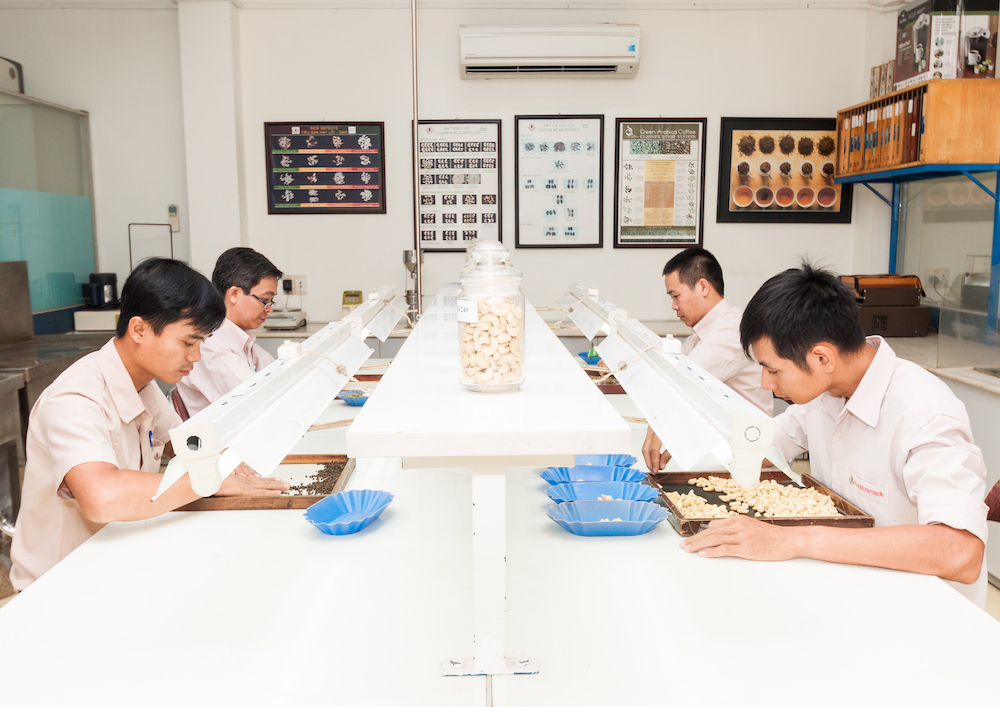Coffee market fluctuation last week: Coffee prices increased slightly
Good news from the world’s two strongest economies: China’s economic growth in the first quarter of 2021 increased by 18.3%, retail sales increased and unemployment fell in the US, together with the promise of The Fed chairman on not raising the basic interest rate in USD for a long time, which has helped the stock investors feel more confident. The US stock indexes rose to historic highs. Gold metal and crude oil prices both increased.
Not only the price of stocks and derivatives increased, the capital flow to virtual currency exchanges was also strong. Bitcoin at one point touched above 64,000 USD/Btc on April 14 when Coinbase company listed on Nasdaq. By the morning of April 17, 2021, these exchanges included 4,990 types of virtual currencies that attracted nearly 2.27 trillion USD. It can be said that when virtual currencies rose, the agricultural derivatives market was greatly “divided” because the speculative attraction in virtual currencies was getting stronger while many people were looking for ways to make a profit in the context that the Covid-19 pandemic has not been contained, although the vaccination program has been actively conducted.
The Dollar Value Index (DXY) added another week of falling results. From the highest peak of 93.33 points since nearly 5 months, DXY closed last week’s session at 91.53 points. Analysts and financial traders believe that DXY is still in a downtrend if it loses the area of 91.20 points. The lowest area of DXY was established in early January 2021 of around 89.50-90 points. In the past time, the price of the two coffee floors could not go low, which is probably thanks to the depreciation of the USD, which is reflected in the DXY.
The Baltic Dry index (BDI) last week touched 2,385 points, the highest level since more than a year (figure 1-left). For the whole of last week, BDI increased by 14.4% after the Ever Given ship ran aground in the Suez Canal, the lifeline of goods between Asia and Europe. Moreover, the shortage of empty containers and empty space on ships has caused the freight rates to continue to increase intensely so far.
Supply and demand news for the week
Brazilian coffee exports and ending stocks
The Brazilian coffee crop is usually counted from the beginning of July of the previous year and ends at the end of June of the following year. The first nine months of the crop year (07/2020-03/2021) is estimated at 31.41 million bags (bag=60 kgs). If we take the output of this crop at 60 million bags, extracting about 20 million bags for domestic consumption, it can be seen that the country has about 10 million bags left for export. With that much coffee, Brazil is more than enough to supply the world market in the last three months of the crop. Depending on the forecast and calculation of internal supply-demand factors, each business will have its own Brazil ending inventory. Assuming someone guesses 65 million bags, the inventory carried over to the new crop will be 5 million bags.
Brazil has begun harvesting robusta, followed by arabica in July. The average number of many forecasts for Brazilian coffee production in the new crop year is about 52 million bags, most estimate that the robusta production will increase by about 10% but the Arabica production will decrease by 35%.
Vietnam’s coffee exports in March 2021 increased
The General Department of Vietnam Customs estimates that Vietnam exported about 169,424 tons of coffee, up 38% over the same period in 2020. Thus, in the first three months of 2021, Vietnam exported about 456,010 tons, worth 809 million USD, decreased by 12.2% in volume and 7% in value over the same period in 2020.
Available inventory in North America decreased
The American Green Coffee Association (GCA) reported that the available inventories in the US and Canada by the end of March 2021 decreased to 340,750 tons from 347,434 tons in the previous month. This includes 5,510 tons of Arabica coffee on the New York floor. Each week, the whole North America region consumes about 36,000 tons. Thus, the above inventory can be sold within 9.5 weeks.
The North American coffee inventories in June 2015 were around 330 thousand tons, the last month’s figure was only 10 thousand tons higher than the lowest month. This could be a positive factor for this week’s price, mainly on Arabica floor.
Coffee inventory meets the standards of 2 coffee floors
Compared to last week’s report of NCIF, the coffee inventory recorded in this period: New York arabica floor is 112,521 tons compared to last week’s 111,668 tons, of which only about 5% is located in the US, the rest in Europe. Inventories of Robusta standards on the London floor continued to decrease to 146,520 tons from 147,420 tons last week.
Price
After a week to April 16, the price of two coffee floors increased slightly. Particularly on the robusta floor, when detecting a large oversold in hand, traders bought back to help London price increase in the midweek. The final results are as follows:
-London robusta floor increased by 17 USD to close at 1,380 USD/ton with a range of 1,395-1,359.
-New York arabica floor increased 2.05 cts/lb or 45 usd/ton within a range of 135.45-127.60.
-The price of export coffee grade 2 with 5% broken black fluctuated from 32.3 to 32.9 million VND/ton with 32.7 million VND at the end of the week, an average increase of 0.4 million VND/ton compared to the last week.
Technical analysis of robusta coffee prices for the week of April 19-24, 2021: The price only increases when it breaks through the old frame.

FIGURE 2 – ROBUSTA LONDON COFFEE PRICE CHANGE IN JULY 2021
Standing at the closing position of 1.380 with a weekly range of 1.395-1.359, it can be said as follows:
-Recently, although the robusta floor has many opportunities to increase when the New York price increased heavily, the DXY index decreases steadily and the Brl of the UsdBrl currency pair strengthens, but the London floor is only satisfied with the accumulation activity as analyzed in last week’s report (1).
-Without escaping from 1,395, the situation becomes more ominous. However, considering that the bottom of 1.341 made on April 6 is gradually being raised, the concern is reduced.
-The downside risk will appear once this floor drops and especially closes below 1.371 because then London seems to want to return to 1.360 to gather more buying power. Assuming a loss of 1.359, then prepare yourself for the return of 1.340-1,345.
-Opportunity to increase once London breaks out of 1,395 with extremely large volume because it has tried this level many times but all failed. Only then (above 1.395) will the price pass the psychologically important 1,400 level. Investment funds buy against losses from the zone of 1,406 and above. Closing above this level of 1,406 could count the way up another 30 USD.
-This week’s trading will be seen as cumulative if London fails to break out of the 1.345-1,395 bracket.
-The business position of large investment funds as of the closing date of April 13 was reported to increase sharply by oversold with over 4,000 contracts compared to just over 500 lots before. It is possible that this week they will try to buy back, but the price increases strongly or weakly depending on the amount of purchase.
Impact on the domestic coffee market: It is difficult to predict the long-term.
When the virtual currency exchanges have not shared much on the capital flow, the agricultural product exchanges in general and coffee in particular can also orient the market within 6 to 12 months or more. Today, capital flows in the financial markets freely flow, not in one place but elsewhere, while the average Brazilian coffee production in the coming years will be around a high level of 55-60 million bags (60 kg = bags) and especially, its ability to take the leading position in the production and export of robusta is increasingly evident.
In the past few months, it is rare to see the domestic price of coffee exceed 34 million VND/ton, but the price of 32 million VND/ton is very often threatened. Therefore, it must be said that the current coffee business is no longer the same as before, which means you can speculate and wait for the price to rise or buy ready to wait for the price to increase before selling.
The coffee market has reached the level of commoditization, or rather it should be called high commoditization, because the price of any commodity is subject to the flow of capital in the financial market. This period also shows that it is not in the hands of a huge amount of goods that can be controlled or “priced” in the market.
Therefore, the producer needs to transfer the price risk to the trader, that is, to produce the goods is to calculate the full cost and sell it directly to the exporter if he does not want to bear the risk of loss or depending on “rescue”. As for traders, they have the full range of tools to protect themselves from trading losses.
In the past time, the pressure on the price is not really due to supply and demand, but rather to those who hold a lot of money “self-directed”, not necessarily investing in a single channel no matter how much they love a commodity.
As for the domestic price of coffee this week, it is predicted that the price may be around 32.2-33.2 million VND/ton, but it is difficult to expect a higher level.








